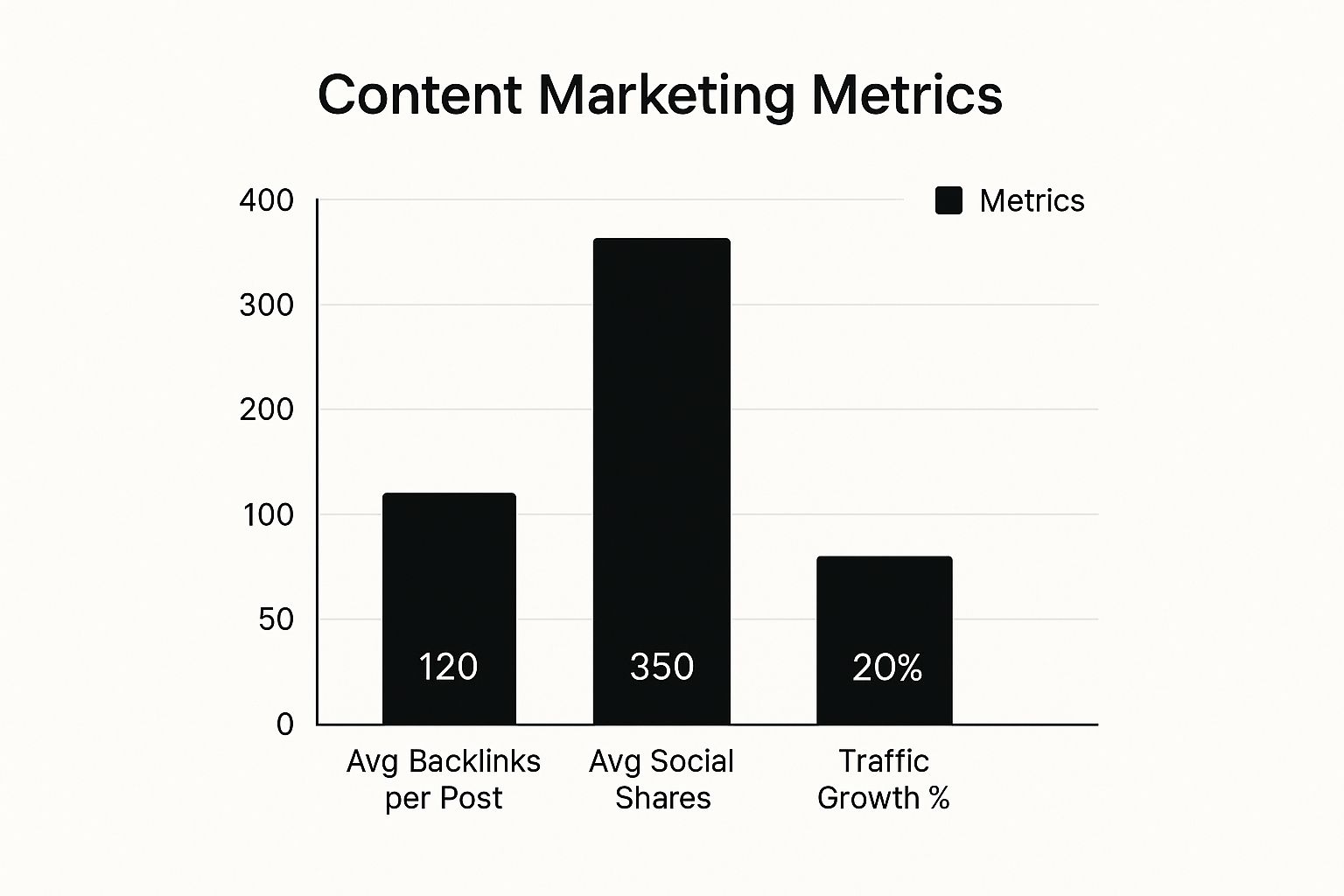
7 Blog writing Examples you should know
Sections
Studying theory is one thing, but seeing it in action is another. That’s why analyzing high-quality blog writing examples is one of the fastest ways to improve your own content. It allows you to move beyond abstract best practices and see exactly how successful brands and creators capture attention, drive traffic, and convert readers. Simply put, great blog posts are not accidents; they are carefully constructed assets designed to achieve specific business goals.
This article breaks down the “how” and “why” behind exceptional blog content. Instead of just showing you a list of links, we will dissect seven distinct types of blog posts, from comprehensive ultimate guides to compelling personal case studies. For each example, we will analyze the underlying strategy, pinpoint specific tactics you can replicate, and provide actionable takeaways to implement immediately. You will learn how top-tier content creators structure their arguments, engage their audience, and optimize for search engines.
Whether you’re a seasoned digital marketer, a small business owner aiming to boost visibility, or a blogger looking to sharpen your skills, these examples provide a clear blueprint for success. Let’s dive into the models that work and learn how to build content that delivers measurable results.
#1. The List Post (Listicle)
Kicking off our list of essential blog writing examples is the format that defined an era of digital content: the list post, or “listicle.” This structured format presents information in a numbered or bulleted list, making it exceptionally easy for readers to scan, digest, and extract value. Its inherent organization promises a clear, finite amount of information, which is highly appealing to time-strapped audiences.

Pioneered by sites like BuzzFeed and refined for B2B marketing by hubs like HubSpot, listicles thrive because they deliver on their title’s promise. A title like “7 Ways to Improve Your SEO” immediately tells the reader the exact structure and quantity of takeaways they will receive. This clarity reduces reader friction and increases click-through rates.
#Strategic Analysis: Why Listicles Work
The power of the listicle lies in its psychological appeal and structural efficiency. The human brain craves order and finds numbered lists easier to process and remember than dense prose. This format inherently creates scannable content, which is crucial for retaining readers who often skim online articles.
Key Insight: Listicles transform complex topics into a series of self-contained, digestible points. Each list item acts as a mini-headline, continuously re-engaging the reader’s attention as they scroll down the page.
Moreover, listicles are highly shareable. The concise and value-packed nature makes them ideal for social media, where users can share a post that promises quick, actionable tips or entertaining rankings. This built-in virality is a significant driver of organic traffic.
#Actionable Takeaways for Your Blog
To create a powerful list post, focus on delivering substantial value within a simple structure.
- Use Specific, Intriguing Numbers: Odd numbers, particularly 7, 9, and 13, have been shown to attract more clicks. Be specific; “17 Actionable Tips” is more compelling than “Some Tips.”
- Make Each Point a Standalone Gem: Every item on your list should offer distinct value. Treat each point as a mini-article with its own clear heading, explanation, and example.
- Enhance with Visuals: Break up the text by including relevant images, screenshots, or custom graphics for each list item. This improves readability and engagement.
- Write a Powerful Conclusion: Don’t just end on the last list item. Add a concluding paragraph that summarizes the key takeaways and includes a strong call to action (CTA).
#2. The How-To Tutorial
Next on our list of essential blog writing examples is the how-to tutorial, a cornerstone of value-driven content. This format provides comprehensive, instructional guidance, walking readers through a specific process or task from start to finish. Its immense popularity stems from its direct utility; it solves a reader’s problem with actionable, step-by-step instructions.

This post type is a staple for authorities like Backlinko and Moz, who built their reputations on detailed guides that demystify complex topics like SEO. By teaching a skill, you position your brand as a helpful expert and build trust. A well-executed tutorial, such as a step-by-step guide to keyword research, becomes a go-to resource that readers bookmark and return to, generating sustained traffic.
#Strategic Analysis: Why How-To Tutorials Work
The effectiveness of the how-to post lies in its ability to directly address user intent, particularly for informational and transactional search queries. When a user searches for “how to [accomplish a task],” they have a clear goal. A tutorial that satisfies this need is highly likely to rank well and earn user loyalty. These posts are evergreen content machines, remaining relevant long after publication.
Key Insight: How-to tutorials transform your blog from a passive source of information into an active tool. By guiding the user through a process, you create an interactive experience that fosters a deeper connection and demonstrates your product’s or service’s value in a real-world context.
Furthermore, these guides are natural link magnets. Other websites are more likely to link to a comprehensive tutorial that serves as a definitive resource on a topic, which is a powerful driver for building domain authority and improving search rankings.
#Actionable Takeaways for Your Blog
To craft a tutorial that stands out and delivers real value, focus on clarity, detail, and user experience.
- Break It Down Logically: Deconstruct a complex process into a series of numbered, easy-to-follow steps. Use clear, action-oriented subheadings for each stage (e.g., “Step 1: Gather Your Materials,” “Step 2: Configure the Settings”).
- Visualize Every Step: Use annotated screenshots, custom graphics, or short video clips to illustrate each action. Visual aids are critical for preventing confusion and ensuring the reader can successfully follow along.
- Include Prerequisites and Tools: Start the post by clearly listing any necessary tools, software, or prior knowledge required. This sets expectations and prevents reader frustration.
- Test and Refine: Before publishing, have someone unfamiliar with the process follow your instructions to the letter. This helps identify any confusing steps or gaps in your explanation.
#3. The Personal Story/Case Study
Moving beyond purely informational formats, the personal story or case study uses narrative to build a powerful connection with the audience. This blog writing example weaves together personal experiences, challenges, and successes to teach a lesson or illustrate a point. By grounding advice in a real-world context, it makes abstract concepts tangible and relatable, fostering trust and authenticity.
This format has been masterfully used by thought leaders like James Clear, who often opens his articles on habit formation with a compelling historical or personal anecdote. Similarly, Buffer’s famed transparency posts, which openly shared salary data and internal challenges, are prime examples of using a company’s journey as a teaching tool. This narrative-driven approach transforms a simple blog post into a memorable and impactful experience.
#Strategic Analysis: Why Personal Stories Work
The effectiveness of the personal story lies in its ability to trigger empathy and build rapport. Humans are hardwired for stories; a well-told narrative can capture attention and make information more memorable than a list of facts. This format allows the author to be vulnerable, which in turn makes the brand feel more human and trustworthy.
Key Insight: Personal stories and case studies serve as proof of concept. They don’t just tell the reader what to do; they show them how it was done, including the struggles and failures along the way. This transparency makes the eventual success feel more attainable.
Strategically, these posts excel at building brand affinity and authority. When readers connect with your story, they are not just consuming content; they are forming a relationship with you or your brand. This emotional investment is invaluable for long-term audience loyalty and engagement.
#Actionable Takeaways for Your Blog
To craft a compelling personal story or case study, blend narrative with clear, practical value.
- Anchor the Story to a Universal Lesson: Your personal experience is the vehicle, not the destination. Ensure your story clearly connects to a broader, actionable takeaway that benefits the reader.
- Be Vulnerable, But with a Purpose: Share specific details, data, and even failures. Honesty builds trust, but always frame it within the context of the lesson you are teaching.
- Structure for Impact: Start with a narrative hook to draw the reader in. Build the story, introduce the conflict or challenge, and then transition to the resolution and the lessons learned.
- Conclude with Clear Takeaways: After telling the story, summarize the key principles in a clear, skimmable format like a bulleted list. This ensures readers can easily extract and apply your advice.
#4. The Ultimate Guide/Pillar Post
For those looking to establish true authority and dominate search rankings for a core topic, the ultimate guide, or pillar post, is the gold standard of blog writing examples. This format is a comprehensive, deep-dive article that covers a subject so exhaustively it becomes the definitive resource for readers. Unlike a standard blog post, a pillar post is a long-form asset, often exceeding 3,000 words, designed to be bookmarked and referenced repeatedly.
Pioneered by content marketing strategists like Brian Dean of Backlinko and the team at HubSpot, these posts serve as central hubs in a topic cluster model. For example, a massive guide on SEO will link out to more specific “cluster” articles on topics like keyword research or link building. This structure signals topical authority to search engines and provides immense value to the reader in one place.
#Strategic Analysis: Why Ultimate Guides Work
The power of the pillar post lies in its sheer depth and value, which directly appeals to both users and search engine algorithms. By covering every conceivable angle of a topic, it satisfies user intent at all stages of the buyer’s journey, from beginner awareness to expert-level inquiry. This comprehensive coverage makes it a magnet for backlinks from other sites looking to cite a credible source.
Key Insight: Pillar posts are built for long-term SEO success. They attract high-quality links, accumulate authority over time, and can be continuously updated to maintain their “evergreen” status, ensuring they remain relevant and continue to draw organic traffic for years.
Strategically, these guides establish your brand as a market leader. When you publish the best resource on a subject, you become the go-to authority, building trust and credibility that extends far beyond a single blog post.
#Actionable Takeaways for Your Blog
Creating a successful ultimate guide is a significant undertaking that requires meticulous planning and execution.
- Build a Detailed Outline: Before writing a single word, map out every subtopic you need to cover. Use headings (H2, H3, H4) to structure the content logically.
- Include a Table of Contents: For long-form content, a clickable table of contents is non-negotiable. It improves user experience by allowing readers to navigate directly to the sections they need. For a solid example, you can see how a complete guide to search engine optimization is structured.
- Use Diverse Content Formats: Break up the massive walls of text with custom graphics, videos, checklists, and embedded tools. This keeps readers engaged and makes complex information easier to digest.
- Plan for Regular Updates: A pillar post is a living document. Schedule quarterly or biannual reviews to update statistics, add new information, and fix broken links to ensure it remains the most current and valuable resource available.
#5. The Curated Roundup
Next in our showcase of powerful blog writing examples is the curated roundup. This format acts as a service to your audience by collecting, organizing, and presenting the best content, tools, or expert insights on a specific subject. Instead of creating everything from scratch, the author adds value through selection and commentary, saving readers countless hours of research.
This model has been perfected by newsletters like Morning Brew and The Hustle, which distill daily business news into witty, digestible summaries. Similarly, industry experts like Ann Handley and Benedict Evans use roundups to share their perspective on the latest trends, positioning themselves as indispensable guides within their niches. The core value proposition is clear: trust the expert to find what matters.
#Strategic Analysis: Why Roundups Work
The curated roundup’s success is built on trust and efficiency. In an era of information overload, readers are desperate for reliable filters. By consistently delivering high-quality, relevant resources, you become a go-to source, building immense loyalty and establishing your brand as a central hub in your industry.
Key Insight: Roundups build authority not by claiming to know everything, but by demonstrating you know where to find the best information. This act of service positions you as a knowledgeable and generous leader in your field.
Furthermore, this format is an excellent way to network and build relationships. Featuring other experts, tools, or articles often leads to social media shares, backlinks, and reciprocal mentions from those you highlight. Regularly publishing roundups can also be a key strategy for developing topical authority, signaling to search engines that you are a comprehensive resource on a subject. You can learn more about building topical authority on rankdigger.com.
#Actionable Takeaways for Your Blog
To create a roundup post that stands out, focus on the quality of your curation and the depth of your commentary.
- Add Your Unique Commentary: Don’t just list links. Explain why each item is included and what makes it valuable. Your personal insight is the primary reason readers will return.
- Establish a Consistent Format: Whether it’s a “Top 5 of the Week” or a monthly “Best Tools For…”, a predictable structure helps readers know what to expect and makes the content easier to consume.
- Mix Well-Known and Hidden Gems: Include links to established authorities to build credibility, but also uncover lesser-known resources to provide unique value and surprise your audience.
- Encourage Audience Participation: End your post by asking readers to submit their own suggestions for the next roundup. This fosters community and provides you with fresh content ideas.
#6. The Interview Post
Leveraging the authority and audience of an expert, the interview post is one of the most powerful blog writing examples for building credibility. This format centers on a conversation with a thought leader, industry expert, or influential personality, presented either as a direct Q&A or a narrative-driven article. It’s an effective way to provide fresh, high-value insights directly from a primary source.
Pioneered in the digital space by figures like Tim Ferriss and Andrew Warner of Mixergy, this format borrows from traditional journalism to create compelling content. Instead of just stating facts, you present a genuine dialogue, which adds a layer of authenticity and human connection. The interviewee’s reputation and expertise lend immediate weight to your content.
#Strategic Analysis: Why Interview Posts Work
The strategic genius of the interview post is its ability to “borrow” credibility and reach. By featuring a respected figure, you instantly gain the trust of their followers and associate your brand with their authority. This format is a mutual win: you get expert content for your audience, and the interviewee gets exposure to a new one.
Key Insight: Interview posts turn your blog into a platform for industry voices. This shifts the dynamic from you being the sole expert to you being a trusted curator of expert knowledge, which can be a more scalable and authoritative position.
Furthermore, these posts often generate significant referral traffic. The interviewee is highly likely to share the published article with their own network, driving a warm, relevant audience directly to your site. This built-in distribution mechanism is a core benefit of this content type.
#Actionable Takeaways for Your Blog
To execute a successful interview post, preparation and respect are paramount.
- Research Deeply and Prepare Thoughtful Questions: Avoid generic questions the expert has answered a dozen times. Dig into their past work and ask specific, insightful questions that uncover new stories or perspectives.
- Structure for Readability: Whether you use a Q&A format or a narrative style, break up the text. Use bold for the questions, blockquotes for powerful statements, and clear subheadings to guide the reader.
- Preserve the Expert’s Voice: Edit for clarity and flow, but be careful not to strip away the interviewee’s personality and authentic voice. The goal is a clean transcript, not a sanitized one.
- Make Sharing Easy: When the post goes live, send a link to your interviewee with pre-written social media posts and custom graphics. This makes it effortless for them to share the content with their audience.
#7. The Data-Driven Research Post
For brands seeking to establish true authority and become a go-to resource, the data-driven research post is the ultimate power play. This blog writing example involves conducting original research, surveys, or data analysis and publishing the findings. It transforms your blog from a content publisher into a primary source, generating valuable backlinks and media mentions.
Instead of commenting on existing industry trends, you create the data that defines them. Iconic examples include HubSpot’s annual “State of Marketing” reports, Moz’s deep dives into search engine ranking factors, and Buffer’s social media benchmarks. These pieces are foundational assets that build immense brand credibility and organic traffic over time.
This chart visualizes the typical performance metrics of a well-executed research post compared to standard blog content.

The data clearly illustrates that the high-effort nature of these posts correlates directly with high-value outcomes in backlinks, social engagement, and traffic growth.
#Strategic Analysis: Why Data-Driven Posts Work
The strategic value of original research lies in its inherent scarcity and authority. While thousands of blogs can write about a topic, only one can be the source of the data. This creates a powerful content moat, making your post a magnet for backlinks from journalists, fellow bloggers, and industry analysts who cite your findings.
Key Insight: Data-driven posts shift your content strategy from renting an audience to owning a conversation. By generating proprietary data, you become an indispensable resource that others must reference, building long-term SEO equity.
These posts also have an extended shelf life. An annual report or a benchmark study can remain relevant and continue to attract traffic and links for years, making the initial investment in research highly efficient over the long term.
#Actionable Takeaways for Your Blog
Creating a successful research post requires a methodical approach from conception to promotion.
- Ensure Methodological Transparency: Clearly explain how you collected and analyzed your data. A transparent methodology builds trust and credibility, making others more likely to cite your work.
- Visualize the Story: Use charts, graphs, and infographics to make complex data understandable and engaging. Compelling visuals are highly shareable and help communicate key findings quickly.
- Draw Actionable Conclusions: Don’t just present raw data. Interpret the findings for your audience and explain what the numbers mean for their strategy or business.
- Create a Promotion Plan: Your work isn’t done when you hit publish. Actively promote your research to relevant journalists, influencers, and industry publications to secure citations and backlinks.
#7 Key Blog Writing Style Comparison
| Blog Post Type | Implementation Complexity 🔄 | Resource Requirements ⚡ | Expected Outcomes 📊 | Ideal Use Cases 💡 | Key Advantages ⭐ |
|---|---|---|---|---|---|
| The List Post (Listicle) | Low – easy to structure and write | Low – mostly writing and images | High shareability and SEO benefits | How-to guides, tips, recommendations | Easy to scan, highly shareable |
| The How-To Tutorial | Medium to High – requires detailed steps | Medium to High – visuals, testing | Builds authority, consistent traffic, conversions | Teaching processes or skills | Actionable guidance, trusted source |
| The Personal Story/Case Study | Medium – narrative crafting and disclosure | Low to Medium – mainly writing | Strong engagement, emotional connection | Sharing experiences, teaching lessons | Authenticity, unique content |
| The Ultimate Guide/Pillar Post | High – extensive research and writing | High – research, visuals, updates | Establishes topical authority, SEO powerhouse | Comprehensive topic coverage | Definitive resource, backlink magnet |
| The Curated Roundup | Low to Medium – gathering and summarizing | Low – content discovery and commentary | Builds relationships, consistent value | Collecting expert opinions, resources | Quick to produce, positions as curator |
| The Interview Post | Medium to High – coordination and editing | Medium – scheduling, transcription | Unique insights, expands network | Expert perspectives, thought leadership | Leverages authority, original content |
| The Data-Driven Research Post | High – original research, data analysis | High – data collection, expertise | High credibility, media citations, backlinks | Industry trends, market insights | Authoritative, thought leadership |
#Final Thoughts
We’ve journeyed through a diverse landscape of powerful blog writing examples, dissecting everything from detailed how-to tutorials and comprehensive ultimate guides to engaging personal stories and data-driven research posts. The goal wasn’t just to show you what great content looks like, but to uncover the strategic scaffolding that makes it successful. By breaking down these real-world posts, we’ve revealed the replicable tactics that drive engagement, build authority, and climb search engine rankings.
The most critical takeaway is that exceptional blogging is never accidental. It is a deliberate fusion of art and science. The “art” lies in the storytelling, the unique voice, and the creative presentation. The “science” is in the structure, the SEO optimization, the audience understanding, and the strategic formatting choices that make the content accessible and actionable.
#Your Blueprint for Better Blogging
As you move forward, let these examples serve as your strategic blueprint. Don’t just admire a well-crafted listicle or an in-depth case study; deconstruct it. Ask yourself why it works. Is it the compelling headline? The logical flow? The use of custom visuals to clarify complex points? Or the strategic placement of internal links to guide readers deeper into their site?
Remember these core principles, which we saw repeated across all successful examples:
- Audience-Centricity: Every great post starts with a deep understanding of the reader’s pain points, questions, and goals. The content is crafted to serve their needs first and foremost.
- Structured for Skimming: Modern readers are busy. Effective posts use short paragraphs, clear headings, bullet points, and bold text to make key information easy to find and digest.
- Actionable Insights: Simply presenting information isn’t enough. The best blog posts empower readers by providing clear, actionable takeaways and next steps, transforming passive readers into active doers.
- Strategic SEO: High-performing content is built on a solid SEO foundation. This includes targeted keywords, optimized headings, descriptive alt text for images, and a smart internal linking strategy to build topical authority.
#From Inspiration to Implementation
The true value of studying these blog writing examples lies in applying the lessons to your own work. The next time you sit down to write, don’t just start typing. Begin with a plan. Choose a format that best suits your topic and your audience’s needs. Outline your key points, identify your target keywords, and think about how you can add unique value that no one else is offering.
Mastering these different blog formats will equip you with a versatile toolkit, allowing you to tackle any topic with confidence and precision. Whether you’re building a pillar page to establish authority or writing a personal case study to build trust, you now have the framework to create content that not only attracts visitors but also converts them into loyal followers and customers.
Ready to take the guesswork out of your content strategy and find the exact keywords your audience is searching for? Rankdigger is a powerful SEO tool that helps you uncover high-potential keywords, analyze your competitors, and track your ranking performance. Stop creating content in the dark and start building a blog that drives measurable results with Rankdigger.

